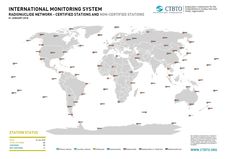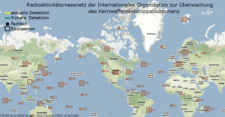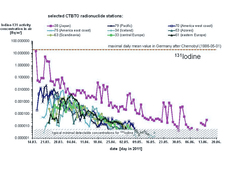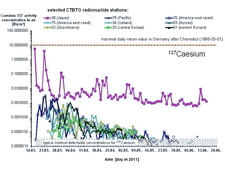-
Topics
subnavigation
Topics
Electromagnetic fields
- What are electromagnetic fields?
- Static and low-frequency fields
- Radiation protection relating to the expansion of the national grid
- High-frequency fields
- Radiation protection in mobile communication
Optical radiation
Ionising radiation
- What is ionising radiation?
- Radioactivity in the environment
- Applications in medicine
- Applications in daily life and in technology
- Effects
- What are the effects of radiation?
- Effects of selected radioactive materials
- Consequences of a radiation accident
- Cancer and leukaemia
- Genetic radiation effects
- Individual radiosensitivity
- Epidemiology of radiation-induced diseases
- Ionising radiation: positive effects?
- Risk estimation and assessment
- Radiation protection
- Nuclear accident management
- Service offers
-
The BfS
subnavigation
The BfS
- About us
- Science and research
- Laws and regulations
- BfS Topics in the Bundestag
- Links
Trace analysis worldwide - Analysis of the Fukushima release
- The CTBTO has a worldwide network. Once fully completed it consists of 80 radionuclide measurement stations for detection of radionuclides bound to airborne dust. In addition 40 of these stations are equipped with systems for the measurement of radioactive xenon (xenon-133).
- One of these radionuclide measurement stations is operated by the Federal Office for Radiation Protection (BfS) on Mt Schauinsland near Freiburg im Breisgau.
- After the accident at the nuclear power plant in Fukushima, Japan, in 2011, the station was able to detect the slightest traces of radioactivity from Fukushima.

![]() The CTBTO's global monitoring network of radionuclide measurement stations (as of 1 January 2018). Stations marked with an "R" have systems for determining radioactivity bound to airborne dust (such as caesium-137). Stations marked with "R+" additionally have noble gas measurement systems for the determination of radioactive xenon isotopes.
Source: CTBTO (www.ctbto.org/maps/)
The CTBTO's global monitoring network of radionuclide measurement stations (as of 1 January 2018). Stations marked with an "R" have systems for determining radioactivity bound to airborne dust (such as caesium-137). Stations marked with "R+" additionally have noble gas measurement systems for the determination of radioactive xenon isotopes.
Source: CTBTO (www.ctbto.org/maps/)
The international Comprehensive Nuclear-Test-Ban Treaty Organization (CTBTO) has a worldwide network of more than 60 operating radionuclide measurement stations in order to be able to detect radionuclides bound to airborne dust. Furthermore, 31 of these stations are equipped with systems for the measurement of radioactive xenon (xenon-133). Once fully completed, the network will operate 80 radionuclide measurement stations worldwide, 40 of which will be equipped with noble gas monitoring technology.
One of these radionuclide measurement stations is operated by the Federal Office for Radiation Protection (BfS) on Mt Schauinsland near Freiburg im Breisgau. Its measurement systems are certified:
- The measurement system for the detection of radionuclides bound to airborne dust has been certified according to the requirements of the CTBTO since 2004.
- The noble gas measurement system operating since 2004 as part of the so-called International Noble Gas Experiment was certified on 11 November 2013 by the CTBTO.
Radioactive Xenon is a noble gas. In contrast to iodine-131, it is neither deposited on the ground nor does it get into food and is therefore comparatively insignificant for radiation protection. However, it is one of the radioactive substances which escape particularly rapidly - for example from nuclear power plants or medical isotope production facilities - in the event of a possible release. Xenon is not washed from the atmosphere by rain and can thus be easily transported over long distances.
Together with the Federal Institute for Geosciences and Natural Resources (BGR), the BfS has the duty to maintain the national data centre for Germany and evaluates the data from the CTBTO monitoring network.
The monitoring stations of the CTBTO are not aimed at detecting radioactivity as quickly as possible but at being able to detect slightest traces of artificial radioactivity. Due to the time-consuming methods used for this purpose, the results are only available after a time lag of about three days after the end of the sampling period.
Trace analysis results of the accident in Fukushima
Worldwide detection of radionuclides
Worldwide detection of radionuclides

![]() The animated map shows the CTBTO radioactivity monitoring network and the time sequence in which the artificial radionuclides from Fukushima were detected at the stations after the incident in Japan.The animated map shows the CTBTO radioactivity monitoring network and the time sequence in which the artificial radionuclides from Fukushima were detected at the stations after the incident in Japan.
The animated map shows the CTBTO radioactivity monitoring network and the time sequence in which the artificial radionuclides from Fukushima were detected at the stations after the incident in Japan.The animated map shows the CTBTO radioactivity monitoring network and the time sequence in which the artificial radionuclides from Fukushima were detected at the stations after the incident in Japan.
The animated map shows the CTBTO radioactivity monitoring network and the time sequence in which the artificial radionuclides from Fukushima were detected at the stations. The stations are located as indicated by the dots on the map. A surrounding square marks the places where radioactive xenon can additionally be measured. The identification numbers of the stations are also used in the keys of the figures below.
The animation shows how the radioactive substances were dispersed by the west winds, first over North America and then over Europe towards the east. Barely three weeks after the reactor accident of 12 March 2011, radioactivity from Fukushima was detected at all measuring stations located in the northern hemisphere of the earth. In the southern hemisphere no artificial radioactivity was measured during this period. This can be explained by the very low exchange of air masses across the equator. Radioactive traces from Fukushima were temporarily detected only in New Guinea and the Fiji Islands which were still affected by air masses from the northern hemisphere during that season.
Starting from mid-April, it could be observed how the activity concentrations for artificial radionuclides dropped back below the limit of detection; first at the measuring stations in the Pacific and from early May 2011 on, also in Europe. The main explanation for this is that the radioactive substances bound to small airborne dust particles are washed from the air and deposit on the ground.
Activity concentrations of iodine-131 and caesium-137
Time series of the activity concentrations of iodine-131 and caesium-137 in the CTBTO radioactivity monitoring network

![]() Time series of the activity concentration of iodine-131 measured to date in the air at nine representative radioactivity measurement stations of the International Monitoring System to verify compliance with the Comprehensive Test Ban Treaty.
Time series of the activity concentration of iodine-131 measured to date in the air at nine representative radioactivity measurement stations of the International Monitoring System to verify compliance with the Comprehensive Test Ban Treaty.
The figures on the right show the time series of the activity concentrations of iodine-131 and caesium-137 in the air at selected measuring stations of the monitoring network:
- Takasaki (station 38) located only about 200 km south-west from the reactor Fukushima I,
- Hawaii (station 79) in the Pacific,
- Sacramento (station 70) on the West Coast and Charlottesville (station 75) on the East Coast of the USA,
- Iceland (station 34) and São Miguel (Azores, station 53) in the Atlantic as well as
- Mt Schauinsland near Freiburg (station 33), Stockholm (station 63) and Dubna (western Russia, station 61) in Continental Europe.
On account of the extreme differences in the detected activity concentrations, the measurement values are displayed on a logarithmic scale.

![]() Time series of the activity concentration of caesium-137 measured to date in the air at nine representative radioactivity measurement stations of the International Monitoring System to verify compliance with the Comprehensive Test Ban Treaty. The graph shows the time series during the first three months after the reactor accident.
Time series of the activity concentration of caesium-137 measured to date in the air at nine representative radioactivity measurement stations of the International Monitoring System to verify compliance with the Comprehensive Test Ban Treaty. The graph shows the time series during the first three months after the reactor accident.
During the first three weeks after the reactor accident in Fukushima, the dilution effect with increasing distance to the scene of the accident can be clearly observed. In further course, the measurement values of the stations converge, indicating decreasing releases from the destroyed nuclear power plant as well as the gradual mixing of air masses from the northern hemisphere. The measurement values at the Japanese station Takasaki (station 38) are considerably higher - as expected - due to its close proximity to the destroyed nuclear power plant and the contamination of the measurement system itself.
It can be seen in the figures that the measurement values for iodine-131 decrease faster than those for caesium-137 which can be attributed to the difference in the half-lives of the two radionuclides. Iodine-131 decays with a half-life of 8 days, whereas caesium-137 decays with a half-life of 30 years.
In mid-May the activity concentrations of Iodine-131 at the represented stations - with the exception of the Japanese station Takasaki (station 38) - fell below the station-specific limits of detection. These limits of detection depend on the local conditions at the individual stations and are therefore not displayed in the graph as fixed values but as shaded areas. The Fukushima events have impressively demonstrated that the CTBTO radioactivity monitoring network makes it possible to monitor the global dispersion of released radionuclides and to estimate possible effects also in more distant areas in a unique fashion.
State of 2018.03.20


